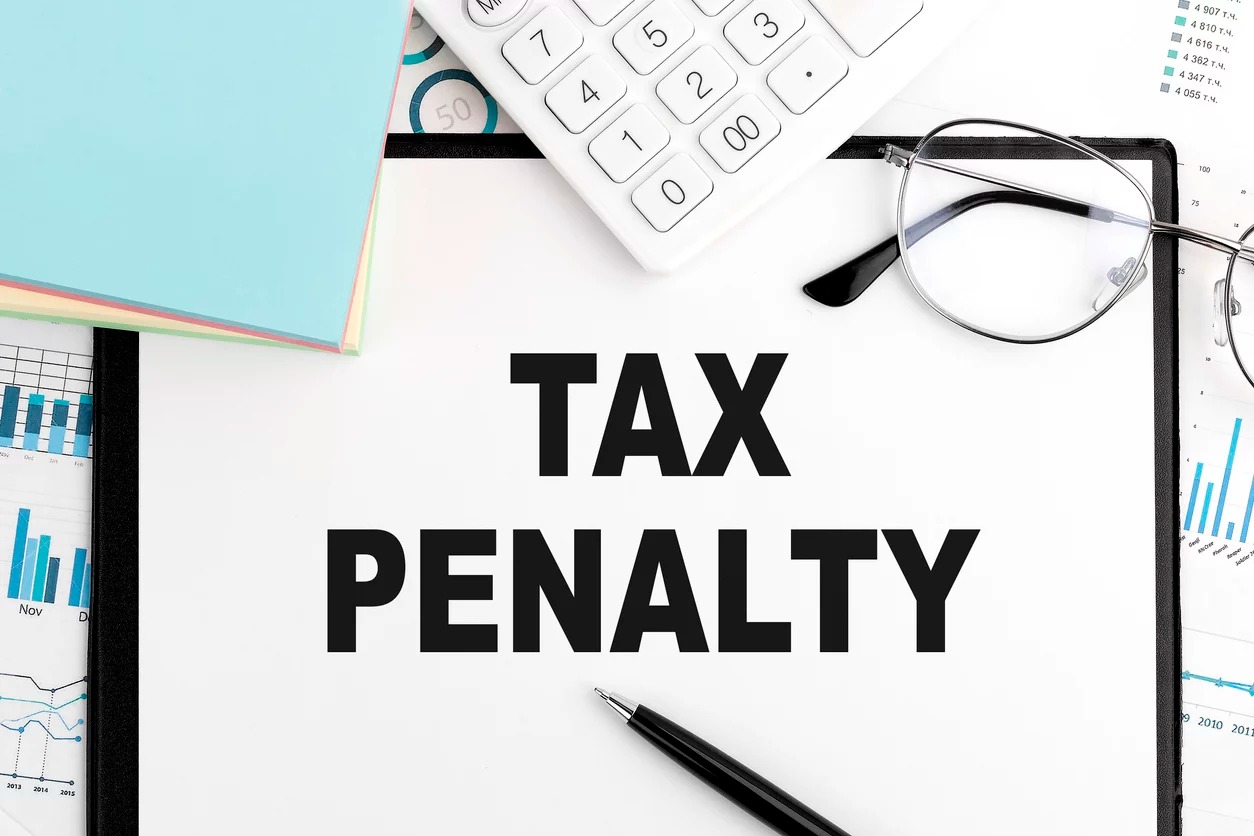

Finance
What Is A Civil Penalty IRS?
Published: October 31, 2023
Learn about civil penalties issued by the IRS for finance-related violations and understand the consequences and procedures involved. Expert insights and guidance to tackle IRS civil penalties.
(Many of the links in this article redirect to a specific reviewed product. Your purchase of these products through affiliate links helps to generate commission for LiveWell, at no extra cost. Learn more)
Table of Contents
- Introduction
- Definition of Civil Penalty
- Overview of the IRS
- Types of Civil Penalties
- Failure to File Penalty
- Failure to Pay Penalty
- Accuracy-Related Penalty
- Fraud Penalty
- Reasonable Cause Penalty Relief
- Amount and Calculation of Civil Penalties
- Consequences of Civil Penalties
- Appeals and Dispute Resolution Process
- Conclusion
Introduction
When it comes to dealing with tax matters, it is essential to understand the potential consequences of non-compliance. One such consequence is the imposition of civil penalties by the Internal Revenue Service (IRS). Civil penalties are financial penalties levied by the IRS for various violations of tax laws and regulations.
Knowing what a civil penalty is and how it can affect you is crucial for anyone involved in financial matters. Whether you’re a taxpayer, a business owner, or a tax professional, understanding civil penalties can help you navigate the complex world of tax compliance.
In this article, we will delve into the realm of civil penalties imposed by the IRS. We’ll provide an overview of what a civil penalty is, explore the different types of civil penalties, discuss the calculation of penalties, and examine the potential consequences for non-payment.
It’s important to note that this article is for informational purposes only and does not constitute legal or tax advice. If you have specific questions about your tax situation or need personalized guidance, it’s always advisable to consult with a qualified tax professional.
Now, let’s dive into the world of civil penalties and gain a deeper understanding of their significance in the realm of tax compliance.
Definition of Civil Penalty
A civil penalty is a financial penalty imposed by a governmental agency, such as the IRS, on individuals or entities who fail to comply with certain laws or regulations. In the context of taxation, civil penalties are levied for violations of tax laws and regulations. The purpose of civil penalties is to encourage voluntary compliance with tax obligations and deter non-compliance.
Unlike criminal penalties, which involve deliberate tax evasion or fraud and can lead to imprisonment, civil penalties serve to address less severe violations and are typically resolved through monetary fines. Civil penalties can be imposed for a wide range of offenses, including failure to file tax returns, failure to pay taxes, inaccuracies on tax returns, or fraud.
Typically, civil penalties are assessed based on a percentage of the amount owed or as a fixed amount per violation. The specific penalty amount varies depending on the type of violation and the applicable laws and regulations. It’s worth noting that civil penalties are subject to review and can be challenged or appealed if there are reasonable grounds to do so.
The purpose of civil penalties is not purely punitive but also aims to encourage voluntary compliance and fairness in the tax system. By imposing penalties, the IRS seeks to ensure that all taxpayers meet their obligations and maintain the integrity of the tax system.
It’s important to note that civil penalties can apply to both individual taxpayers and businesses. Taxpayers should be aware of their obligations and strive to comply with tax laws and regulations to avoid the imposition of civil penalties.
Now that we have a clear understanding of what civil penalties are, let’s delve deeper into the world of the IRS and explore the different types of civil penalties that can be imposed for tax violations.
Overview of the IRS
The Internal Revenue Service (IRS) is the governmental agency responsible for enforcing and administering the tax laws of the United States. It operates under the authority of the Department of the Treasury and plays a crucial role in collecting tax revenue to fund various government programs and services.
The primary mission of the IRS is to ensure that taxpayers understand and comply with their tax obligations. To achieve this mission, the IRS performs a wide range of functions, including processing tax returns, conducting audits, enforcing tax laws, and providing taxpayer assistance and education.
One of the key functions of the IRS is to assess and collect taxes owed by individuals and businesses. This involves processing tax returns, reviewing income and deduction information, and determining the correct amount of tax liability. The IRS also provides resources and tools to help taxpayers understand the tax code and meet their obligations.
In addition to tax collection, the IRS is responsible for enforcing tax laws and regulations. This includes conducting audits to ensure that taxpayers are accurately reporting their income and claiming legitimate deductions and credits. The IRS also investigates cases of suspected tax evasion or fraud and takes appropriate enforcement actions against non-compliant taxpayers.
Furthermore, the IRS provides a variety of services and resources to assist taxpayers in understanding and fulfilling their tax obligations. This includes offering online tools for tax filing and payment, providing guidance on tax matters, and offering taxpayer assistance centers where individuals can seek help with their tax questions and concerns.
Overall, the IRS plays a critical role in maintaining the integrity of the tax system and ensuring that taxpayers meet their obligations. By enforcing tax laws, providing resources and guidance, and collecting revenue, the IRS contributes to the functioning of the government and the provision of essential services to the American public.
Now that we have a broad understanding of the IRS, let’s explore the different types of civil penalties that the IRS can impose for tax violations.
Types of Civil Penalties
The IRS imposes various types of civil penalties to encourage compliance with tax laws and regulations. These penalties can be levied for different types of violations, ranging from failure to file tax returns to intentional tax fraud. Let’s explore some of the most common types of civil penalties imposed by the IRS:
- Failure to File Penalty: This penalty is imposed when a taxpayer fails to submit their tax return by the due date or the extended due date, if applicable. The penalty is calculated based on a percentage of the unpaid tax amount and accrues on a monthly basis.
- Failure to Pay Penalty: If a taxpayer fails to pay their tax liability by the due date, the IRS may impose a failure to pay penalty. This penalty is also calculated based on a percentage of the unpaid tax amount and accrues on a monthly basis.
- Accuracy-Related Penalty: The accuracy-related penalty is imposed when a taxpayer makes significant errors or inaccuracies on their tax return, resulting in an underpayment of taxes. This penalty is typically 20% of the underpaid tax amount and can be imposed for negligence, substantial understatement of income, or other substantial tax-related errors.
- Fraud Penalty: The most severe civil penalty imposed by the IRS is the fraud penalty. It is levied when a taxpayer intentionally underreports income, overstates deductions, or engages in fraudulent activities to evade taxes. The fraud penalty is equal to 75% of the underpaid tax amount and can also result in criminal prosecution.
- Reasonable Cause Penalty Relief: In certain cases, taxpayers may be eligible for penalty relief if they can demonstrate that their failure to comply with tax obligations was due to reasonable cause and not willful neglect. Factors such as illness, natural disasters, or reliance on professional advice may be considered for reasonable cause relief.
It’s important to note that these are just a few examples of the types of civil penalties imposed by the IRS. The specific circumstances of each case can result in different penalty assessments. Additionally, the IRS has guidelines and procedures in place for penalty abatement or reduction for taxpayers who demonstrate financial hardship or other extenuating circumstances.
Understanding the different types of civil penalties is essential for taxpayers to ensure compliance with tax laws and regulations. It’s always advisable to consult with a tax professional to navigate the complexities of tax penalty assessments and explore options for penalty relief, if applicable.
Now that we have explored the various types of civil penalties, let’s move on to understanding how the amount and calculation of these penalties are determined.
Failure to File Penalty
The failure to file penalty is imposed by the IRS when a taxpayer fails to submit their tax return by the due date or the extended due date, if applicable. This penalty is intended to encourage timely filing and reporting of income and is calculated based on a percentage of the unpaid tax amount.
The failure to file penalty accrues on a monthly basis, starting from the day after the tax filing deadline. The penalty rate is typically 5% of the unpaid tax amount for each month or part of a month that the return is late, up to a maximum of 25%. However, if the taxpayer’s return is more than 60 days late, the minimum penalty is either $435 or 100% of the unpaid tax amount, whichever is less. This minimum penalty applies even if the taxpayer has a refund coming.
It is worth noting that if a taxpayer files their return more than 60 days after the due date or extended due date, the minimum penalty will be imposed, unless the taxpayer can provide a reasonable explanation for the delay.
If a taxpayer cannot pay the full amount of taxes owed by the due date, it is still crucial to file the tax return to avoid the failure to file penalty. The IRS offers various options for taxpayers who are unable to pay their taxes in full, such as installment agreements and offers in compromise, which can help avoid additional penalties and interest.
It’s important to remember that the failure to file penalty is separate from the failure to pay penalty. If both penalties apply in a given tax year, the failure to file penalty is typically higher, so timely filing of the return is essential.
If a taxpayer has a reasonable explanation for not filing their tax return on time, they may be eligible for penalty relief under reasonable cause provisions. Reasonable cause relief is granted on a case-by-case basis and may require providing supporting documentation or evidence to demonstrate the reasonable cause for the delay.
To avoid the failure to file penalty, taxpayers should ensure that they meet the tax filing deadlines and submit their returns even if they are unable to pay the full amount of taxes owed. Filing the return on time is crucial to minimize penalties and take advantage of potential penalty relief options.
Now that we have explored the failure to file penalty, let’s move on to understanding the failure to pay penalty imposed by the IRS.
Failure to Pay Penalty
The failure to pay penalty is imposed by the IRS when a taxpayer fails to pay their tax liability by the due date. This penalty is intended to encourage timely payment of taxes and is calculated based on a percentage of the unpaid tax amount.
The failure to pay penalty accrues on a monthly basis, starting from the day after the tax payment deadline. The penalty rate is typically 0.5% of the unpaid tax amount for each month or part of a month that the tax remains unpaid, up to a maximum of 25%. However, if a taxpayer has an approved installment agreement with the IRS, the penalty rate is reduced to 0.25% for that period.
It’s important to note that the failure to pay penalty can be significantly lower than the failure to file penalty. If both penalties apply in a given tax year, the failure to pay penalty will generally be half of the failure to file penalty.
If a taxpayer cannot pay the full amount of taxes owed by the due date, it is still crucial to file the tax return to avoid the failure to file penalty. The failure to pay penalty can be avoided or minimized by paying as much as possible by the due date and exploring payment options offered by the IRS, such as installment agreements or offers in compromise.
In some cases, the IRS may offer penalty relief under reasonable cause provisions for failure to pay penalties. Reasonable cause relief is granted on a case-by-case basis and may require providing supporting documentation or evidence to demonstrate reasonable cause for the delay in payment.
It’s important to understand that the failure to pay penalty is separate from interest charges on the unpaid tax amount. Interest is typically charged on the unpaid taxes from the due date of the return until the taxes are paid in full. This interest rate is determined by the IRS and is subject to change periodically.
To avoid the failure to pay penalty, taxpayers should make every effort to pay their taxes in full by the due date. If full payment is not possible, it is important to explore payment options and contact the IRS to discuss potential alternatives.
Now that we have explored the failure to pay penalty, let’s move on to discussing the accuracy-related penalty imposed by the IRS.
Accuracy-Related Penalty
The accuracy-related penalty is imposed by the IRS when a taxpayer makes significant errors or inaccuracies on their tax return that result in an underpayment of taxes. This penalty is intended to promote accuracy and integrity in tax reporting and calculations.
The accuracy-related penalty is typically assessed at a rate of 20% of the underpaid tax amount. It can be imposed for various reasons, including negligence, substantial understatement of income, substantial valuation misstatements, or substantial overstatements of deductions or credits.
Negligence refers to a lack of reasonable care in preparing the tax return, such as failing to maintain proper records or not adequately reviewing the return for errors. Substantial understatement of income occurs when the reported income is significantly less than the actual income received. Substantial valuation misstatements involve significantly overstating or understating the value of property or assets. Substantial overstatements of deductions or credits occur when deductions or credits are claimed that are not supported by adequate documentation or are not eligible for such claims.
It’s important to note that the accuracy-related penalty is generally only imposed if the underpayment of tax is due to a substantial tax reporting error. In cases where the taxpayer has taken reasonable care and made a good-faith effort to comply with tax laws, the penalty may not be imposed.
The IRS provides safe harbor provisions for certain types of errors or underpayments. For example, if the understatement of tax on the return does not exceed the greater of 10% of the correct tax liability or $5,000, the accuracy-related penalty will not be imposed.
To avoid the accuracy-related penalty, taxpayers should take reasonable care in preparing their tax returns, keep accurate and organized records, and review their returns for errors and inconsistencies. It’s also advisable to seek the assistance of a qualified tax professional for complex tax situations.
In cases where the accuracy-related penalty is assessed, taxpayers have the right to dispute the penalty through the IRS appeals process. It’s important to consult with a tax professional or seek expert advice to understand the options available for penalty abatement or reduction.
Now that we have explored the accuracy-related penalty, let’s move on to discussing the fraud penalty and its implications.
Fraud Penalty
The fraud penalty is the most severe civil penalty imposed by the IRS. It is levied when a taxpayer engages in intentional tax fraud to evade paying their fair share of taxes. The purpose of this penalty is to deter fraudulent activities and punish those who attempt to deceive the IRS.
If the IRS determines that a taxpayer has knowingly and intentionally underreported income, overclaimed deductions, or engaged in any fraudulent activity to evade taxes, the fraud penalty may be imposed. The fraud penalty is equal to 75% of the underpaid tax amount resulting from the fraudulent activity.
The fraud penalty is considered a serious offense and can have significant financial and legal consequences. In addition to the penalty itself, taxpayers may also face criminal prosecution and potential imprisonment for willful tax evasion or fraud. The IRS works closely with law enforcement agencies to investigate cases of suspected tax fraud and take appropriate enforcement actions.
Distinguishing between negligence or inadvertent errors and intentional fraud is essential in determining whether the fraud penalty should be imposed. The IRS looks for evidence of fraudulent intent, such as intentionally falsifying documents, maintaining false books and records, or engaging in a pattern of unreported income over multiple years.
It’s important to note that the burden of proof for assessing the fraud penalty rests with the IRS. The IRS must demonstrate that the taxpayer’s actions were willful, deliberate, and intended to deceive. Taxpayers have the right to dispute the fraud penalty through the IRS appeals process and present their case for innocent intent or reasonable cause.
Taxpayers who believe they may be under investigation for fraud or suspect they may have engaged in fraudulent activities should immediately seek the advice of a qualified tax attorney or tax professional. Early intervention and cooperation with the IRS can help mitigate the potential consequences and explore options for resolving the situation.
The fraud penalty serves as a powerful deterrent against intentional tax fraud and reinforces the importance of maintaining honesty and integrity in tax reporting. By adhering to tax laws and regulations and seeking professional guidance when needed, taxpayers can avoid the severe consequences associated with the fraud penalty.
Now that we have explored the fraud penalty, let’s move on to discussing the reasonable cause penalty relief available to taxpayers.
Reasonable Cause Penalty Relief
While the IRS imposes various civil penalties for tax violations, there are provisions in place to grant penalty relief in certain circumstances. One such relief option is known as reasonable cause penalty relief. This relief is available to taxpayers who can demonstrate that their failure to comply with tax obligations was due to reasonable cause and not willful neglect or intentional disregard of the tax laws.
Reasonable cause is determined on a case-by-case basis and takes into consideration the facts and circumstances surrounding the taxpayer’s actions. Examples of situations that may qualify for reasonable cause relief include illness, natural disasters, death in the family, inability to obtain necessary records, reliance on incorrect advice from a tax professional, or other circumstances beyond the taxpayer’s control.
When applying for reasonable cause penalty relief, taxpayers are typically required to provide a written explanation detailing the facts and circumstances that led to the non-compliance or error. Supporting documentation or evidence may also be necessary to substantiate the reasonable cause claim.
It’s important to note that reasonable cause relief is not guaranteed and is subject to the IRS’s discretion. The IRS will carefully review each case to determine if the taxpayer’s circumstances warrant penalty relief. The taxpayer’s compliance history, past actions, and efforts to rectify the error will also be taken into consideration.
It’s highly recommended that taxpayers seek the assistance of a qualified tax professional or tax attorney when applying for reasonable cause penalty relief. These professionals can guide taxpayers through the process, ensure that the necessary documentation is provided, and present a strong case for penalty relief.
It’s worth mentioning that reasonable cause relief is different from other penalty abatement or reduction options. For example, if the taxpayer can show that they had a history of compliance prior to the non-compliant activity, the First-Time Abatement (FTA) option may be available, which provides penalty relief for a first-time offense.
Taxpayers should be aware that reasonable cause relief is specific to penalty relief and does not automatically relieve any interest charges associated with the unpaid tax amount. Interest continues to accrue on the outstanding tax balance until it is paid in full.
Overall, reasonable cause penalty relief provides an opportunity for taxpayers to present their case and seek relief from penalties when they can demonstrate that their non-compliance was due to reasonable cause. By diligently gathering the necessary documentation and working with a tax professional, taxpayers can navigate the process and potentially alleviate some of the financial burdens imposed by civil penalties.
Now that we have explored reasonable cause penalty relief, let’s move on to discussing the calculation and consequences of civil penalties imposed by the IRS.
Amount and Calculation of Civil Penalties
The amount and calculation of civil penalties imposed by the IRS vary depending on the specific type of violation and the applicable tax laws and regulations. Understanding how these penalties are determined can help taxpayers anticipate the potential financial impact of non-compliance.
Civil penalties can be calculated in different ways, including as a percentage of the unpaid tax amount, as a fixed amount per violation, or as a combination of both. Some penalties accrue on a monthly basis, while others may be assessed as a one-time penalty.
For example, the failure to file and failure to pay penalties are typically calculated as a percentage of the unpaid tax amount. The failure to file penalty is generally 5% of the unpaid tax amount for each month or part of a month that the return is late, up to a maximum of 25%, while the failure to pay penalty is 0.5% per month of the unpaid tax amount, also up to a maximum of 25%.
The accuracy-related penalty is usually assessed at a rate of 20% of the underpaid tax amount resulting from significant errors or inaccuracies on the tax return.
On the other hand, the fraud penalty is the most severe civil penalty and is equal to 75% of the underpaid tax amount resulting from intentional tax fraud or evasion.
Penalty amounts can also vary depending on the specific circumstances and severity of the violation. In some cases, the IRS may impose fixed penalties per violation, regardless of the tax amount involved.
It’s important to note that the IRS has guidelines and provisions for penalty abatement or reduction in certain situations. Taxpayers who can demonstrate reasonable cause or meet specific criteria may be eligible for penalty relief. In some cases, penalty relief provisions, such as the First-Time Abatement (FTA) option, may provide relief for taxpayers who have a history of compliance and are facing penalties for the first time.
Consequences for non-payment of civil penalties can range from financial implications to legal actions. Continued non-compliance may lead to the IRS initiating collection activities, such as garnishing wages, placing levies on bank accounts, or filing federal tax liens against a taxpayer’s property. In severe cases, repeated or intentional non-compliance can result in criminal prosecution.
It’s important for taxpayers to take compliance with tax laws and regulations seriously and to promptly address any penalties imposed by the IRS. Seeking the guidance of a qualified tax professional can help navigate the complexity of penalty calculations and explore options for penalty abatement or resolution.
Now that we have explored the amount and calculation of civil penalties, let’s move on to discussing the appeals and dispute resolution process.
Consequences of Civil Penalties
Civil penalties imposed by the IRS can have significant consequences for taxpayers who fail to comply with their tax obligations. These penalties can result in various financial, legal, and reputational repercussions. Understanding the potential consequences of civil penalties is essential for taxpayers to take proactive steps to address non-compliance and avoid further complications.
Financial implications are one of the primary consequences of civil penalties. Penalties are designed to impose monetary fines on taxpayers who violate tax laws or regulations. The amount of the penalty varies depending on the specific violation and can accumulate over time if not addressed promptly. Failure to pay civil penalties can lead to additional interest charges, as the IRS applies interest on the unpaid penalty amount until it is fully paid.
In addition to financial consequences, civil penalties can also have legal implications. Continued non-compliance and failure to address penalties may result in the IRS initiating collection activities against the taxpayer. This can include wage garnishment, bank account levies, or the filing of federal tax liens on the taxpayer’s property. These enforcement actions can significantly impact a taxpayer’s financial stability and creditworthiness.
Furthermore, repeated or intentional non-compliance can escalate the severity of the consequences. The IRS has the authority to pursue criminal prosecution for individuals or businesses engaged in deliberate tax evasion or fraudulent activities. Criminal charges can result in substantial fines, potential imprisonment, and lasting damage to an individual’s or business’s reputation.
Additionally, the existence of unpaid civil penalties can negatively affect a taxpayer’s eligibility for certain government programs, loans, or professional licenses. Failure to address and resolve outstanding penalties can create barriers to accessing financial assistance or engaging in certain professional activities.
It’s crucial to note that civil penalties and their consequences can be mitigated or resolved through various means. Taxpayers have the right to dispute penalties through the IRS appeals process, providing an opportunity to present their case and seek a fair resolution. Moreover, penalty abatement or reduction options, such as reasonable cause relief or first-time abatement provisions, may be available to eligible taxpayers.
To navigate the complexities of civil penalties and their consequences, taxpayers are strongly encouraged to seek the assistance of a qualified tax professional or tax attorney. These professionals can assess the specific circumstances, guide taxpayers through the process, and help negotiate a resolution with the IRS.
Overall, the consequences of civil penalties are not to be taken lightly. They can have lasting financial and legal ramifications. Promptly addressing penalties, understanding one’s rights, and seeking professional guidance are critical in resolving tax non-compliance and minimizing the potential adverse consequences.
Now that we have explored the consequences of civil penalties, let’s move on to discussing the appeals and dispute resolution process with the IRS.
Appeals and Dispute Resolution Process
When taxpayers disagree with the imposition of civil penalties by the IRS, they have the right to dispute the penalties through the appeals and dispute resolution process. This process provides a formal avenue for taxpayers to present their case and seek a fair resolution.
The appeals process is an independent and impartial forum within the IRS designed to resolve tax controversies without going to court. It allows taxpayers to work with an appeals officer who has the authority to reconsider the IRS’s penalty assessment and negotiate a settlement.
To initiate the appeals process, taxpayers must follow the guidelines outlined in the penalty notice received from the IRS. These guidelines will typically include instructions on how to request an appeals conference and the deadline for doing so. It’s crucial for taxpayers to adhere to these deadlines to preserve their right to appeal.
During the appeals conference, taxpayers have the opportunity to present their case and provide any supporting documentation or evidence to support their position. The appeals officer will review the case, consider the taxpayer’s arguments, and make a determination based on the merits of the case.
If the appeals officer upholds the penalty assessment, taxpayers still have the option to pursue further dispute resolution through alternative methods, such as mediation or arbitration. These processes offer a more informal and collaborative approach to resolving tax disputes.
It’s important to note that pursuing the appeals and dispute resolution process may require taxpayers to provide additional information, participate in discussions, and potentially negotiate a settlement. Working with a qualified tax professional or tax attorney can greatly assist in navigating this process and achieving a favorable outcome.
In cases where taxpayers are unable to reach a resolution through the appeals process or alternative dispute resolution methods, they may choose to litigate their case in tax court. This is a more formal legal process where a judge makes a binding decision on the matter.
It’s worth mentioning that while the appeals and dispute resolution process provides a formal platform for resolving tax controversies, it’s always preferable to address tax compliance issues and potential penalties proactively. Timely filing, accurate reporting, and payment of taxes can greatly minimize the need for engaging in the dispute resolution process.
Ultimately, the appeals and dispute resolution process allows taxpayers to challenge the imposition of civil penalties by the IRS and seek a fair resolution. By understanding the process, exercising their rights, and seeking expert guidance, taxpayers can navigate the complexities of tax disputes and work towards a favorable outcome.
Now that we have explored the appeals and dispute resolution process, let’s conclude our discussion on civil penalties and their implications.
Conclusion
Civil penalties imposed by the IRS play a critical role in promoting tax compliance and maintaining the integrity of the tax system. Understanding the implications of these penalties is essential for taxpayers to fulfill their tax obligations and avoid unnecessary financial and legal consequences.
In this article, we explored the definition of civil penalties and their significance in tax compliance. We discussed the different types of civil penalties, including the failure to file penalty, failure to pay penalty, accuracy-related penalty, fraud penalty, and reasonable cause penalty relief.
We emphasized the importance of the IRS in administering and enforcing tax laws, providing an overview of its functions and responsibilities. Additionally, we highlighted the various consequences of civil penalties, such as financial impacts, legal actions, and potential damage to one’s reputation.
We also delved into the appeals and dispute resolution process, highlighting the opportunity for taxpayers to challenge the penalties through the IRS appeals system and pursue alternative dispute resolution options.
Ultimately, taxpayers should strive to be proactive in fulfilling their tax obligations to avoid the imposition of civil penalties. By maintaining accurate records, seeking professional tax advice when needed, and timely addressing any non-compliance issues, taxpayers can minimize their exposure to penalties and other adverse consequences.
It’s important to remember that this article serves as a general guide and does not constitute legal or tax advice. For specific questions or concerns regarding civil penalties, taxpayers should consult with a qualified tax professional or tax attorney.
By staying informed and taking necessary actions, taxpayers can ensure compliance with tax laws and regulations, mitigate the risk of civil penalties, and maintain their financial well-being.














